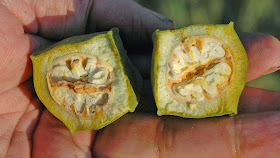We established a pecan cultivar trial down in the Bootheel of Missouri several years back and those trees are starting to yield some first impressions. On my last visit to the planting, a pecan cultivar called Gardner caught my attention (photo at right). Besides a nice crop of nuts, Gardner trees appeared to have far less honey dew and sooty mold covering their leaves as compared to the leaves of all other cultivars in the trial. I'm not suggesting that Gardner is resisitant to aphid feeding because I saw definite signs of aphid feeding on the leaves. However, less honeydew on the foliage indicates that fewer aphids were feeding on these Gardner trees.
In future years, I'll need pay particular attention to how Gardner fares during an outbreak of black-margined aphids.
Gardner was originally found as a street tree growing in Gardner, KS. The origins of this seedling pecan are not known but I can say with certainty that Gardner is a seedling of an improved pecan cultivar. The nut is large (photo at left) averaging 7.23g (63 nuts/lb.) and yielding over 57% kernel.
Gardner is similar to Pawnee in terms of ripening date and the nut even looks a lot like Pawnee. However, Gardner nuts appear more round in cross-section as compared to the more flattened Pawnee. Also like Pawnee, Gardner has a protandrous habit and is susceptible to pecan scab. Fortunately, scab did not appear to be a problem for any of cultivar in our trial this year.
I cut open a Gardner nut during the first week of September and found the kernel to be well filled (photo at right). If we can keep the scab under control, Gardner looks promising.


